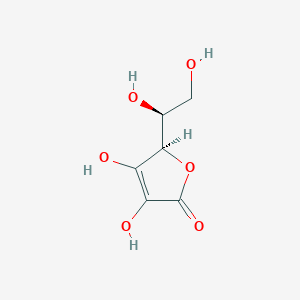Details of Metabolite
| Full List of Protein(s) Regulating This Metabolite | ||||||
|---|---|---|---|---|---|---|
| GPCR secretin (GPCR-2) | ||||||
| Glucagon receptor (GCGR) | Click to Show/Hide the Full List of Regulating Pair(s): 1 Pair(s) | |||||
| Detailed Information |
Protein Info
 click to show the details of this protein click to show the details of this protein
|
|||||
| Regulating Pair |
Experim Info
 click to show the details of experiment for validating this pair click to show the details of experiment for validating this pair
|
[1] | ||||
| Introduced Variation | Knockout of Gcgr | |||||
| Induced Change | Ascorbic acid concentration: decrease (FC = 1.2) | |||||
| Summary | Introduced Variation
|
|||||
| Disease Status | Type 2 diabetes mellitus [ICD-11: 5A11] | |||||
| Details | It is reported that knockout of GCGR leads to the decrease of ascorbic acid levels compared with control group. | |||||
| Nucleobase/ascorbate transporter (NAT) | ||||||
| Solute carrier family 23 member 1 (SLC23A1) | Click to Show/Hide the Full List of Regulating Pair(s): 3 Pair(s) | |||||
| Detailed Information |
Protein Info
 click to show the details of this protein click to show the details of this protein
|
|||||
| Regulating Pair (1) |
Experim Info
 click to show the details of experiment for validating this pair click to show the details of experiment for validating this pair
|
[2] | ||||
| Introduced Variation | Overexpression of SLC23A1 | |||||
| Induced Change | Ascorbic acid concentration: increase (FC = 15) | |||||
| Summary | Introduced Variation
|
|||||
| Disease Status | Healthy individual | |||||
| Details | It is reported that overexpression of SLC23A1 leads to the increase of ascorbic acid levels compared with control group. | |||||
| Regulating Pair (2) |
Experim Info
 click to show the details of experiment for validating this pair click to show the details of experiment for validating this pair
|
[3] | ||||
| Introduced Variation | Mutation (His51Ala) of SLC23A1 | |||||
| Induced Change | Ascorbic acid concentration: increase (FC = 6) | |||||
| Summary | Introduced Variation
|
|||||
| Disease Status | Healthy individual | |||||
| Details | It is reported that mutation (His51Ala) of SLC23A1 leads to the increase of ascorbic acid levels compared with control group. | |||||
| Regulating Pair (3) |
Experim Info
 click to show the details of experiment for validating this pair click to show the details of experiment for validating this pair
|
[4] | ||||
| Introduced Variation | Knockout of Slc23a1 | |||||
| Induced Change | Ascorbic acid concentration: decrease (FC = 3-18) | |||||
| Summary | Introduced Variation
|
|||||
| Disease Status | Healthy individual | |||||
| Details | It is reported that knockout of Slc23a1 leads to the decrease of ascorbic acid levels compared with control group. | |||||
| Solute carrier family 23 member 2 (SLC23A2) | Click to Show/Hide the Full List of Regulating Pair(s): 1 Pair(s) | |||||
| Detailed Information |
Protein Info
 click to show the details of this protein click to show the details of this protein
|
|||||
| Regulating Pair |
Experim Info
 click to show the details of experiment for validating this pair click to show the details of experiment for validating this pair
|
[5] | ||||
| Introduced Variation | Overexpression of SLC23A2 | |||||
| Induced Change | Ascorbic acid concentration: increase | |||||
| Summary | Introduced Variation
|
|||||
| Disease Status | Healthy individual | |||||
| Details | It is reported that overexpression of SLC23A2 leads to the increase of ascorbic acid levels compared with control group. | |||||
If you find any error in data or bug in web service, please kindly report it to Dr. Zhang and Dr. Mou.

